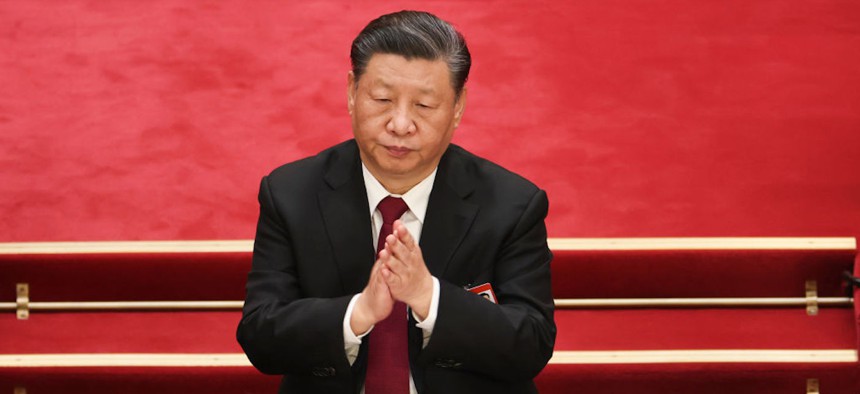
Chinese President Xi Jinping attend the opening of the first session of the 14th National People's Congress at The Great Hall of People on March 5, 2023 in Beijing, China. Photo by Lintao Zhang/Getty Images
Pentagon Requests Science & Tech Research Boost, But China Remains Ahead
Beijing funds much S&T research outside formal military channels.
The Pentagon is seeking $17.8 billion for science and technology research, up from last year's $16.5 billion request, which was itself up from the previous year. But China still appears to have the lead in several key areas of emerging technology.
Requested in the 2024 budget proposal sent to Congress on Monday, the money will go to priorities laid out by the defense undersecretary for research and engineering, including: artificial intelligence, hypersonics (offensive and defensive), directed energy (lasers, particle beams, etc.), microelectronics, biological technology, cyber, fifth-generation communications (5G), autonomy, space, and quantum sciences.
That comes on top of the Pentagon’s 2024 request for $145 billion for research, development, testing and engineering, itself a 4 percent increase over last year’s request, Defense Department Comptroller Mike McChord said today.
In discussing this year’s budget request, McCord emphasized the risk of a conflict with China. Many in the Pentagon are worried that China could make a military play for Taiwan by 2027, if not before.
Such concerns are reflected throughout the budget request, such as $800 million in improved missile defenses for U.S. forces on Guam.
“The regional threat to Guam including those from [People’s Republic of China] continues to rapidly evolve,” said Michelle Atkinson, the director for operations for the Missile Defense Agency, or MDA.
MDA is also asking for $209 million to upgrade the Aegis Ashore missile defense system to better defeat high-maneuvering but low-altitude hypersonic missiles during the glide phase— after liftoff but before they are in the final descent to target. The agency is also looking to launch satellites that can track hypersonics in greater detail. MDA Director Vice Adm. Jon Hill said these satellites would complement the hypersonic missile tracking layer that the Space Development Agency is creating. Dubbed Hypersonic and Ballistic Tracking Space Sensor Satellites or HBTSS, the new satellites will spring into action when cued by warnings from other “wide-view” sensors and satellites, and collect data on hypersonic missiles to feed to interception systems.
MDA’s budget includes some $39 million to “continue our innovation, science and technology program to explore leap ahead and disruptive technologies and develop emerging capabilities to enhance our missile defenses,” Atkinson said.
The United States spends far more money on its military than does China, which earlier this month announced a 7.2 percent increase that will bring its defense budget to $230 billion.
But some other metrics, the United States is hardly in the lead when it comes to science and technology spending.
According to a March analysis from the Australian Strategic Policy Institute, or ASPI, China is currently leading in 37 out of 44 fields “spanning defence, space, robotics, energy, the environment, biotechnology, artificial intelligence (AI), advanced materials and key quantum technology area. ”The tracker measures high-impact research publications in those areas.
While China’s overall military budget is smaller than the United States, its pan-government spending on research and development is comparatively larger: $450 billion in 2022. The Biden administration is looking to increase funding for science outside of the Defense Department, requesting $25 billion this year, a $6.5 billion increase over last year, but it’s still far behind.
Of course, the U.S. spending numbers don’t account for U.S. private-sector spending on research and development,which accounts for about two-thirds of total R&D spending in the United States. But it remains unclear how much of that funding will produce technologies that are useful for defense. And if the resulting research products do have some national-security relevance, it’s unclear how to enlist them for that purpose, especially if the companies that produce them also have financial ties to China, which is something that Biden administration is increasingly focused on.
The fact that a direct comparison between Chinese and U.S. research spending is impossible illustrates the wide differences between the two countries’ views of government’s role in spurring innovation and breakthroughs. The United States remains in perpetual debate about the best way to support the private sector while also providing for a national defense.
FBI Director Christopher Wray, in an appearance before lawmakers this month, described the Chinese government’s relationship with its private sector as direct control. “The difference between an ostensibly private company and the Chinese Communist Party is essentially a distinction without a difference.”



